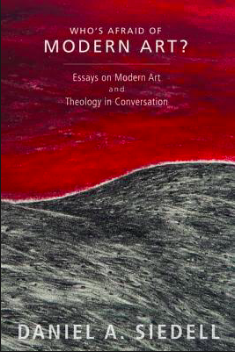Maybe All of Us: A Review of "Who's Afraid of Modern Art?"
Upon cracking open Dr. Dan Siedell’s "Who’s Afraid of Modern Art?", I expected to find long, academic essays on the history and meaning of the modern art movement. Instead, I found a book that ended up functioning as my devotional for the summer.
My previous experience with modern art felt like a failure. Though I studied art history in school, I still felt very putoff by it. I understood some of the movement’s basic ideas, but I didn’t feel represented by it. Many pieces that I saw in galleries made me feel awkward, or sometimes even sick.
Modern art was an even more daunting animal, which is why Siedell’s title spoke to me in the first place. “Who’s Afraid of Modern Art?” Well, me. Siedell claims that’s the point. It’s okay to be scared of modern art because he is too.
“You and I, if we’re honest with ourselves, gravitate toward a theology that resembles Joel Osteen and art that resembles a Thomas Kinkade painting,” Siedell says.
I had to put the book down after I read that line. I felt incredibility convicted. It was true. I had been running away from modern art because I didn’t want to wrestle with it. I would rather be comforted than confronted.
Modern art shows me an image of myself that I don’t want to accept. I don’t want to admit that the distorted figure in the painting is a mirror image of me. I am ugly and broken, and so is the world around me. Siedell claims, however, that this is why he is drawn to modern art in the first place. It reveals the things that we don’t want to see.
It is through this darkness we are able to better understand God’s grace.
Siedell shares the example of Andres Serrano’s Piss Christ,a photograph of Christ on the cross submerged in the artist’s own blood and urine. Many Christian conservatives reacted with disgust upon hearing about it, claiming that Serrano insulted the Christian tradition with his bodily fluids.
However, the actual photograph looks far less crude than its description. It is a shining, dare I say glorious Christ. The blood and urine are used to illuminate Christ’s figure. Though we shy away from improper topics like bodily fluids, they are, ironically, the means by which we live. We all have to poop. We all have to urinate. And sometimes, we all have to bleed. It is through these vulgar processes that our bodies fix themselves. They act as a means of grace, a way for us to clean ourselves out, to keep functioning.
Piss Christ | Photo from Sotheby's
Serrano’s photograph shows Christ submerged in water, not to insult church tradition, but rather to show how Christ contaminated himself for the church. He meets us at our lowest. It is through our dirtiness that he shows us grace.
Not every work of modern art is about Christ, and we shouldn’t make it out to be so. But as Siedell says, God can work even through grotesque and confusing images.
Our task as the viewer is to be open and passive. We are not called to make these works of art bend to our will. We are called to humble ourselves in order receive the grace that can be shown to us through these images.


